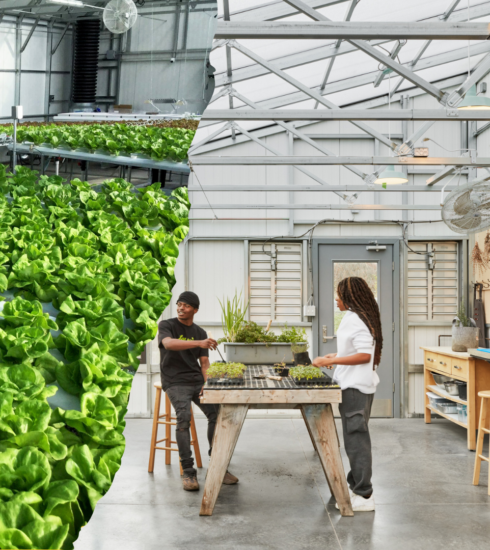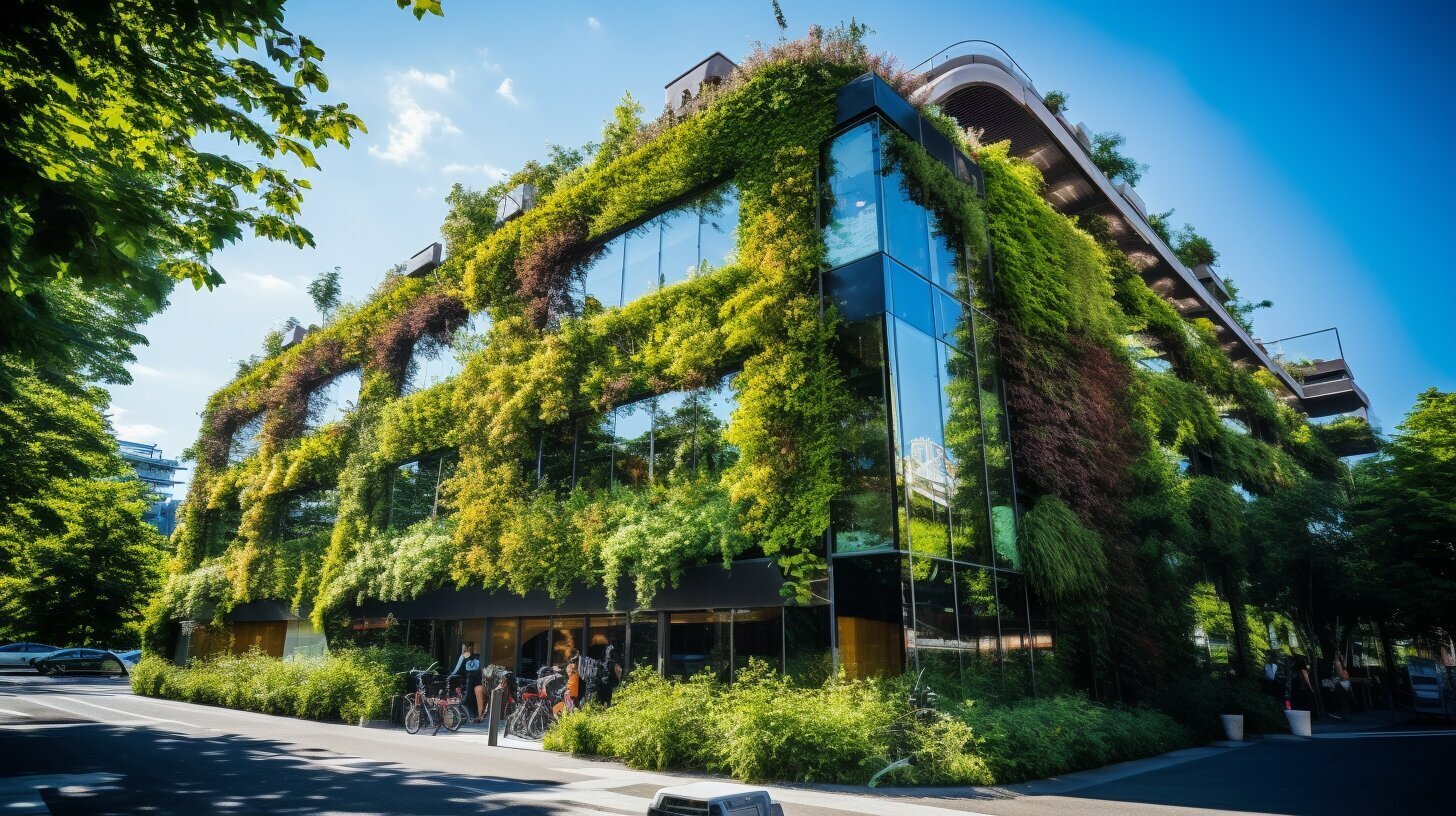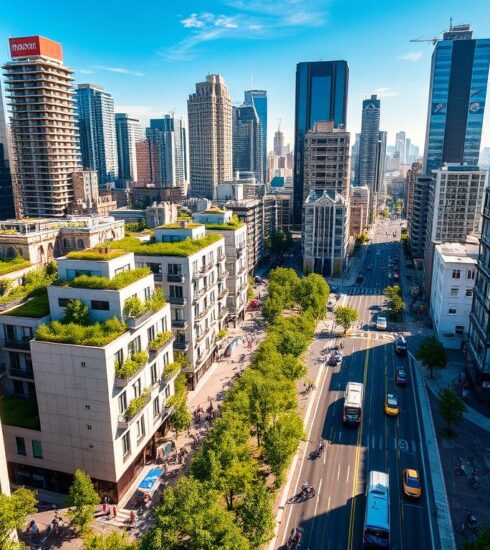Bridging the Gap: Urban Design’s Role in Social Equity
- Jackie De Burca
- November 18, 2024
In the dynamic urban landscapes of the 21st century, the role of urban design has become increasingly pivotal in promoting social equity and creating inclusive communities. The concept of the “1/18 Hour City” has shed light on the stark realities faced by many low-income households and marginalized communities, where limited access to public transportation, affordable housing, and essential services can perpetuate cycles of inequality and disadvantage1.
However, cities around the world have demonstrated that strategic investments in urban design can bridge these gaps and foster more equitable, sustainable, and liveable environments for all residents. From Portland, Oregon’s 50% increase in public transportation ridership to San Francisco’s creation of over 10,000 affordable housing units1, these positive examples highlight the transformative potential of thoughtful urban planning and design.
Key Takeaways
- Urban design plays a crucial role in shaping cities and promoting social equity.
- The “1/18 Hour City” concept reveals challenges like limited public transportation and access to essential services in low-income neighbourhoods.
- Successful initiatives in cities like Portland and San Francisco demonstrate the impact of investing in public transportation and affordable housing.
- Community engagement, affordable housing, transportation access, and inclusive public spaces are key focus areas for creating equitable, sustainable communities.
- Integrating urban design with social equity principles can bridge gaps and improve the liveability of cities for all residents.
Understanding Urban Design and Its Importance
Urban design is a multifaceted discipline that encompasses the planning, development, and management of cities to ensure liveability, sustainability, and social equity2. It combines architecture, planning, and landscape architecture to address the physical environment’s qualities at various scales, from streetscapes to regions2. Urban design tools have been successfully utilised in suburban and rural areas besides urban settings2, playing a crucial role in implementing growth management activities and making significant infrastructure projects more human-centred2.
Definition of Urban Design
Urban design is a collaborative process that involves the explicit, public decision-making to create inclusive public spaces, promote affordable housing, and improve transportation access2. It differs from single-client master planning, as urban design entails multiple objectives for multiple clients2. Additionally, urban design considers the sensory environment, addressing how people perceive and interact with their surroundings2.
Historical Context of Urban Design
The historical context of urban design reveals its evolution from a top-down approach to a more collaborative process involving community engagement2. In the past, urban planning decisions in the US, including restrictive covenants, redlining, and federal housing regulations, reinforced racial and socio-economic segregation3. This led to smaller, poorly maintained public spaces in minority neighbourhoods, perpetuating social isolation and unsanitary conditions3.
Key Principles of Effective Urban Design
Effective urban design addresses these historical inequities and focuses on creating spaces that serve all residents equally2. Key principles include engaging diverse community stakeholders, understanding community needs, and designing for flexibility and adaptability3. Additionally, urban design projects typically consider implications at both project boundaries and larger surroundings, addressing regional and landscape-scale objectives2.
| Principle | Description |
|---|---|
| Participatory Design | Engaging local communities and understanding their needs to create inclusive public spaces. |
| Accessibility in Cities | Ensuring that urban environments are accessible and welcoming to people of all abilities. |
| Human-Centred Urban Design | Prioritising the needs and experiences of people in the design of cities and public spaces. |
“Urban design solutions have been instrumental in implementing growth management activities and making significant infrastructure projects more human-centered.”2
The Connection Between Urban Design and Social Equity
Urban design plays a crucial role in promoting social equity within communities4. Social capital, a concept first introduced in 1916, refers to the networks, resources, and connections that empower individuals and foster community cohesion4. Urban design that prioritizes social equity can facilitate the building of social capital, addressing issues such as housing inequities, transportation disparities, and unequal access to essential services.
Why Social Equity Matters
Social equity in urban planning ensures the fair distribution of resources, opportunities, and benefits across all members of a community4. Researchers like Pierre Bourdieu and James Coleman have highlighted the importance of social capital in addressing economic and cultural inequalities4. Furthermore, the decline of social capital, as noted in Robert Putnam’s seminal work “Bowling Alone,” has significant implications for community well-being and resilience.
The Impact of Urban Design on Communities
Well-designed urban spaces can have a profound impact on communities, fostering social interactions, collaboration, and a sense of belonging4. For example, the transformation of Times Square in New York City into a pedestrian-friendly plaza resulted in a significant increase in foot traffic and social interactions5. Similarly, the redevelopment of the Dudley Street Neighbourhood in Boston involved extensive community engagement, leading to a vibrant, resident-driven design5.
Integrating community-driven urban development principles into the design process can result in more equitable and inclusive spaces that reflect the collective aspirations of residents4. This approach, which considers local attributes, opportunities, and values, is essential for sustainable urban design that promotes social capital and community well-being4.
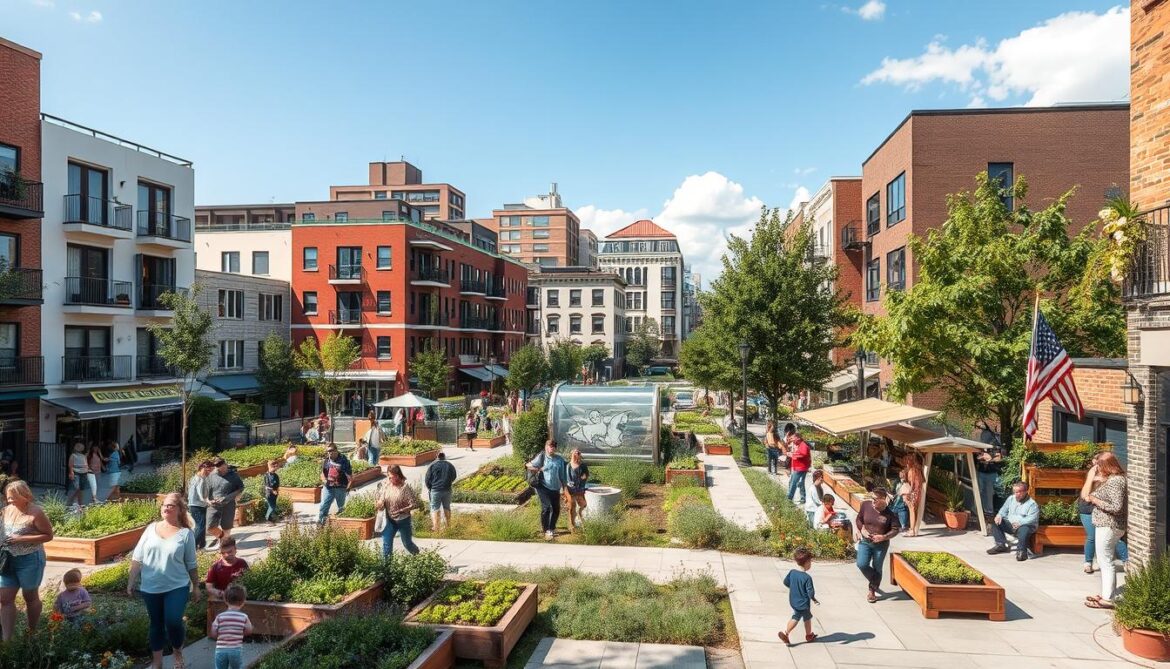
“Urban design shapes spaces with and for communities, fostering interaction, collaboration, and a sense of belonging among residents.” – Researcher
Investigating the relationship between urban design and social capital can inform more effective strategies aligned with the Sustainable Development Goals4. By prioritizing social equity in urban planning, designers and policymakers can create vibrant, inclusive, and resilient communities that empower all residents456.
Inclusive Urban Planning Processes
Inclusive urban planning involves engaging local communities in the decision-making process. Cities like Portland have implemented community engagement programmes to ensure residents’ voices are heard7. Stakeholder collaboration brings together diverse perspectives, including those of marginalised communities. Transparent decision-making builds trust between planners and residents, leading to better outcomes7. This approach helps identify community needs and preferences, ensuring that urban planning decisions reflect diverse perspectives and promote social equity.
Engaging Local Communities
Effective urban planning requires active participation from local communities7. Planners must create opportunities for residents to share their experiences, concerns, and aspirations for their neighbourhoods7. By fostering open dialogues and incorporating community feedback, planning processes can better address the unique needs of diverse populations.
Stakeholder Collaboration
Inclusive urban planning involves bringing together a range of stakeholders, including community organisations, businesses, and policymakers7. This collaborative approach helps to identify shared goals and develop holistic solutions that cater to the diverse needs of the community8. Strategies like Barcelona’s “Superblocks” initiative and Medellín’s investment in transportation and public spaces demonstrate the benefits of stakeholder engagement and community-driven urban development.
Transparent Decision-Making
Transparency in the urban planning process is crucial for building trust and ensuring equitable outcomes7. Planners must communicate openly with the community, providing clear information about decision-making processes and the rationale behind their recommendations8. This transparency can help to address challenges such as lack of community engagement and pressure from political and economic interests, ultimately leading to more inclusive and sustainable urban environments.
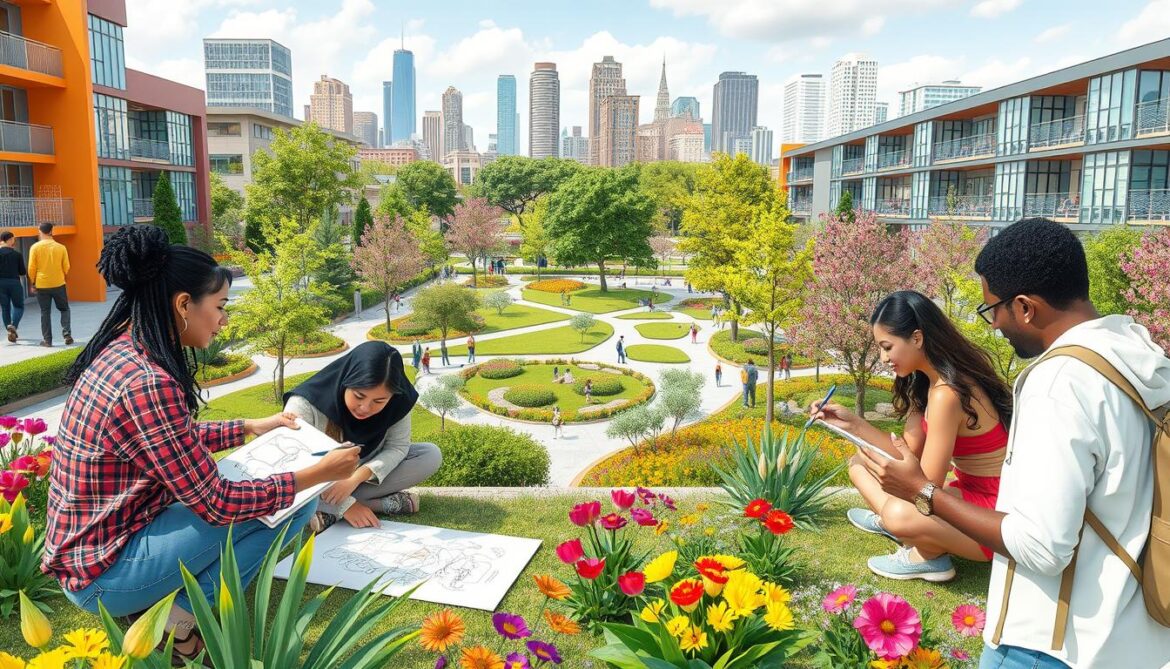
Designing Public Spaces for Everyone
Equitable public spaces are crucial for fostering social cohesion and community well-being in urban areas. Thoughtful placemaking for diversity can transform underutilised or neglected spaces into vibrant hubs that cater to the needs of all residents, regardless of their background or abilities9.
Accessibility in Parks and Recreation Areas
Designing inclusive parks and recreation areas is a vital step towards ensuring equitable access to public amenities. Studies show that communities with access to green spaces have a 15% lower incidence of mental health issues9. Furthermore, public spaces designed for accessibility have shown a 12% increase in foot traffic, indicating higher usage rates by a wider range of individuals9.
Safe and Welcoming Environments
Creating safe and welcoming public spaces is essential for fostering a sense of community and belonging. Implementing safety features like natural surveillance can reduce crime rates by 25% in the surrounding area9. Additionally, inclusive public spaces have been found to increase social connectedness by 40% in neighborhoods with diverse demographics9.
Promoting Social Interaction through Design
Thoughtful design can enhance opportunities for social interaction and community engagement within public spaces. Public spaces that host cultural events can boost local tourism by up to 30% during peak seasons9, while urban areas with accessible public transportation connections to parks and plazas have seen a 15% increase in economic activity within a half-mile radius9.
By prioritising accessibility, safety, and community-focused design, urban planners and designers can create public spaces that truly cater to the diverse needs of all residents, fostering a sense of belonging and promoting social equity1011.

| Design Principle | Description | Objective |
|---|---|---|
| Accessibility | Ensuring public spaces are physically and economically accessible to all community members, including those with disabilities or limited mobility. | Promote inclusivity and equal access to public amenities. |
| Safety | Incorporating design features that enhance safety and security, such as natural surveillance, adequate lighting, and clear sightlines. | Foster a sense of safety and comfort, encouraging greater use of public spaces. |
| Social Interaction | Designing public spaces that encourage social interaction, such as seating areas, communal gathering spaces, and opportunities for cultural and community events. | Strengthen social cohesion and a sense of community within the neighbourhood. |
“Well-designed parks that are accessible, specific, authentic, adaptable, and functional can enhance neighbourhood assets and improve quality of life.”10
Transportation and Connectivity
Accessible and equitable transportation is vital for connecting people to essential services, employment opportunities, and community resources. Unfortunately, many cities face challenges in providing reliable and affordable transportation, especially in underserved neighbourhoods. To address this issue, urban designers are exploring innovative solutions that prioritise accessibility and sustainable mobility.
Integrating Public Transport
Cities are increasingly investing in public transportation infrastructure to enhance connectivity and accessibility. For instance, the city of Los Angeles is committing $2.1 billion to build the 8.5-mile Crenshaw-LAX connector light rail network12. Similarly, the Eglinton Crosstown West extension in Toronto is a $4.6 billion project that will include a major new transit station in the Mount Dennis neighbourhood, which is expected to experience a doubling of its population over the next 20 to 30 years12.
Walkability and Cycling Infrastructure
Promoting walkable and bikeable communities is another crucial aspect of enhancing transportation equity. The Destination Crenshaw project in Los Angeles is investing over $100 million to artistically redesign the at-grade portion of a light rail corridor, making it more pedestrian-friendly12. Similarly, Austin, Texas is implementing a $10.3 billion public transit system, Project Connect, which includes adding 92 new transit stations to improve accessibility and connectivity across the city12.
Reducing Barriers to Mobility
Urban designers are also focusing on reducing physical and psychological barriers to accessing transportation services. In New York City, the design of social service spaces plays a crucial role in providing non-judgmental access to essential resources13. Designing inclusive spaces that cater to different income levels, employment statuses, age groups, and gender identities can enhance social equity and encourage individuals to utilise available services13.
By integrating public transport, improving walkability and cycling infrastructure, and reducing barriers to mobility, urban designers can create more accessible and sustainable communities that provide equitable access to essential services and opportunities for all residents.
“Designing inclusive public spaces leads to better overall city health, benefitting all residents.”
Affordable Housing and Urban Design
Affordable housing is a crucial component of social equity in urban planning. Many cities struggle to provide safe and accessible housing options, particularly for low-income families. Strategies such as inclusionary zoning, which requires developers to include affordable units in new projects, have proven effective14. For instance, San Francisco’s implementation of inclusionary zoning has resulted in the creation of over 10,000 affordable housing units14. Urban designers must consider housing affordability and accessibility when planning new developments to promote more inclusive and diverse communities.
The Role of Urban Design in Housing Equity
Urban design can play a significant role in addressing housing inequity. Innovative housing typologies and thoughtful community planning can cater to the diverse needs of residents15. Less than 18% of American households consist of married parents with children, while approximately 28% of individuals in the U.S. live alone15. Architects and designers must explore alternative housing models to accommodate these changing demographic trends and promote greater social inclusion.
Strategies for Increasing Affordable Housing
Addressing the affordable housing crisis requires a multifaceted approach14. The Roosevelt Island Housing Competition in 1974 aimed to double the density figure of a Low-Rise High-Density prototype, focusing on access to the ground level, small open spaces, and community fostering14. Additionally, initiatives like the “New Housing New York” Legacy Project competition in 2006 have sought to address inadequately met housing needs in cities through innovative and sustainable design solutions.
Case Studies of Successful Initiatives
There are inspiring examples of successful affordable housing initiatives driven by urban design principles14. Between 1969 and 1975, the Chief of Architecture at the New York State Urban Development Corporation oversaw the building of housing for over 33,000 families14. Moreover, the Marcus Garvey Park Village in Brownsville, Brooklyn, developed in 1972, featured a density of 55 dwelling units to the acre, slightly higher than neighboring 17-story high-rises14. These projects demonstrate the potential of thoughtful urban design to create equitable and inclusive public spaces.
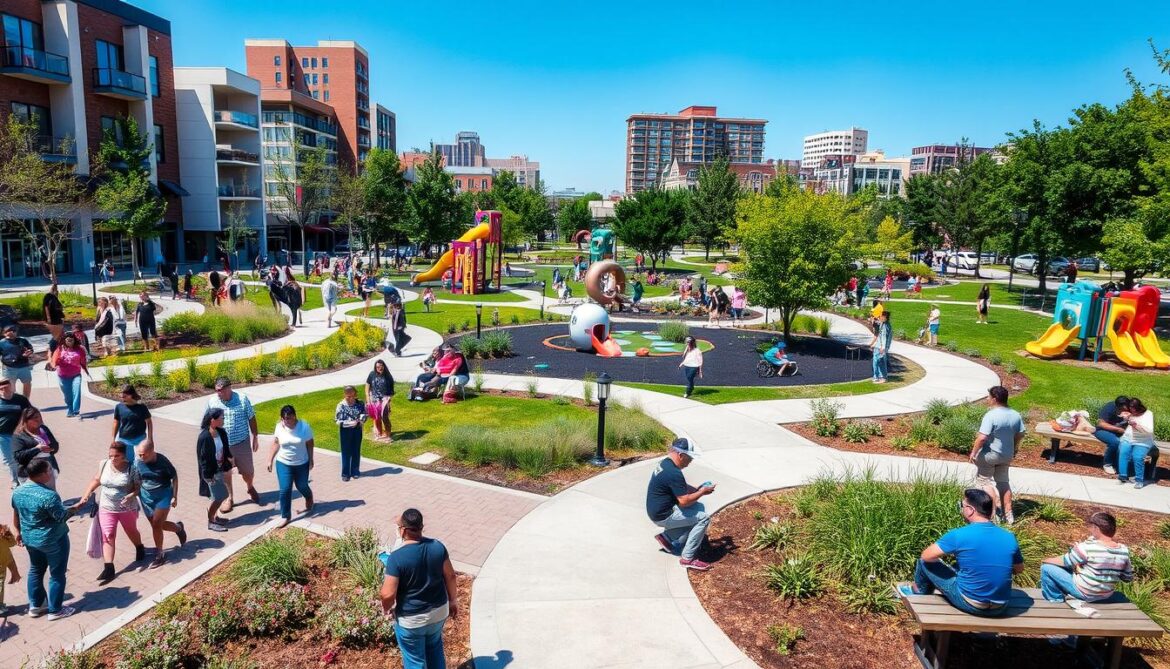
“Diverse housing models can attract a broader range of residents, such as multigenerational households and creatives.”15
Social equity in architectural design involves creating fair and affordable housing, safe communities, and accessible public spaces15. By prioritising these principles, urban designers can contribute to the development of more equitable and sustainable cities.
Green Spaces and Environmental Justice
Urban areas hold immense potential to foster sustainable and equitable communities, and a crucial element in this pursuit is the integration of green spaces. These natural oases within the built environment offer a wealth of benefits, from improving air quality to enhancing mental and physical well-being16. However, the distribution and accessibility of these precious green havens are often uneven, with low-income neighbourhoods typically having fewer such spaces17.
Benefits of Nature in Urban Areas
The presence of green spaces in cities can have a profound impact on the health and well-being of residents16. Studies have shown that exposure to nature can reduce stress, improve mood, and promote social cohesion16. Furthermore, urban green spaces play a vital role in mitigating the urban heat island effect, a phenomenon where cities are typically a few degrees hotter than their surrounding areas17.
Sustainable Design Practices
Achieving environmental justice in urban design requires a holistic approach that prioritizes sustainable design practices. This includes the strategic placement of parks, the implementation of green infrastructure, and the integration of nature-based solutions17. By carefully considering factors such as climate, geography, and water supply, urban planners can create green spaces that are both environmentally and socially sustainable17.
Equitable Access to Green Spaces
One of the key challenges in promoting environmental justice is ensuring equitable access to green spaces17. Research has shown that higher-income and predominantly white neighbourhoods tend to have more green spaces, such as private residences with yards and tree-lined streets, while historically redlined communities often have less access to these vital resources17. Addressing this disparity is crucial in creating sustainable, inclusive communities that provide all residents with the opportunity to experience the benefits of nature18.
By prioritizing green spaces and sustainable design practices, urban planners can play a pivotal role in fostering sustainable communities and promoting equitable public spaces. This holistic approach not only enhances the physical environment but also strengthens social cohesion and supports the overall well-being of all residents16.

“Sustainable development is not just about the environment. It’s about ensuring a better quality of life for everyone, now and for generations to come.”
Cultural Representation in Urban Design
Embracing cultural diversity is essential for creating inclusive and vibrant communities. Incorporating local heritage and identity into urban spaces helps preserve a sense of place and foster a deep connection between residents and their surroundings19. Public art plays a significant role in celebrating community history and values, allowing for a wider range of artistic expressions that resonate with different groups19.
Effective urban design that celebrates diversity often involves close collaboration with local artists and community members19. This collaborative approach ensures that the unique perspectives and needs of all residents are considered, leading to spaces that truly reflect the cultural richness of the area20. By building cultural competency, urban designers can better understand and engage with diverse populations, addressing systemic inequities and fostering trust between planners and the community20.
Incorporating Local Heritage and Identity
Incorporating local heritage and identity into urban design is a powerful way to preserve cultural diversity and foster a sense of belonging. By drawing inspiration from the unique histories, traditions, and artistic expressions of a community, urban designers can create spaces that resonate with residents and celebrate their distinct cultural identities.
The Role of Public Art
Public art plays a vital role in representing the cultural diversity of a community19. Murals, sculptures, and other artistic installations can showcase the stories, symbols, and traditions of different cultural groups, promoting social cohesion and a shared sense of pride among residents19. Furthermore, culturally diverse public art can attract visitors interested in unique cultural experiences, boosting tourism and economic development19.
Celebrating Diversity Through Design
Successful urban design that celebrates diversity often involves a deep understanding of the community’s cultural context and a willingness to collaborate with local stakeholders20. By incorporating elements of diverse cultural heritage, urban designers can create spaces that are welcoming, inclusive, and reflective of the unique identities that make a community vibrant and dynamic.
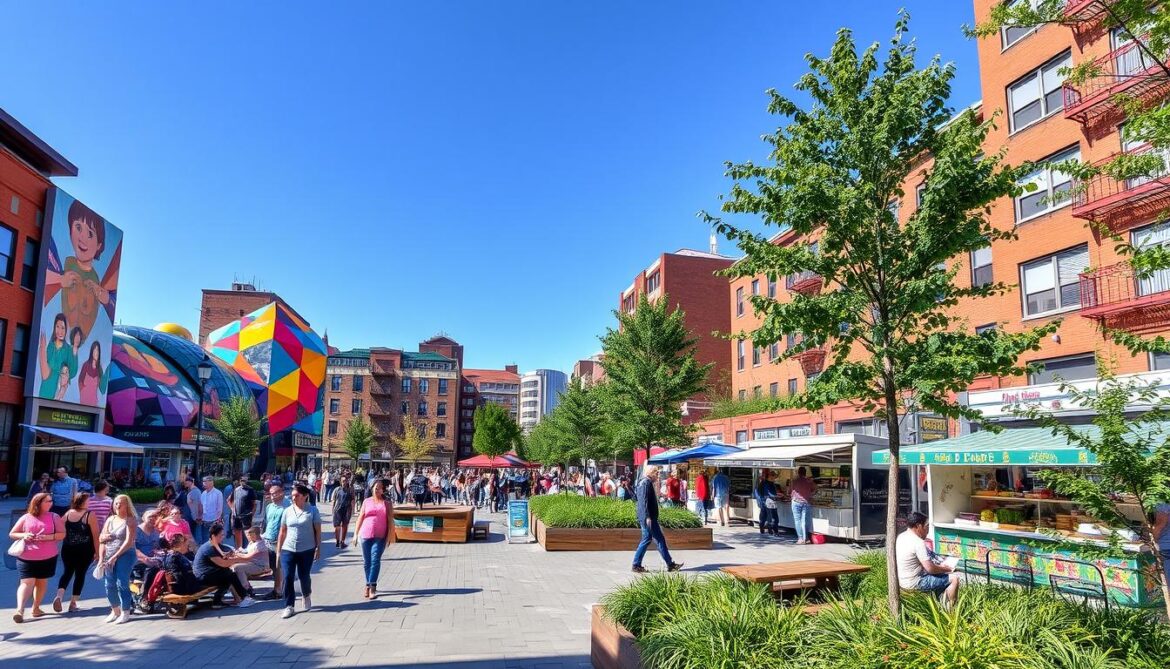
“Designing for diversity is not just about aesthetics – it’s about creating spaces that empower all members of a community to feel seen, heard, and valued.”
The integration of cultural representation in urban design is a crucial step towards building more equitable and inclusive cities. By embracing the rich diversity of a community, urban designers can create spaces that celebrate the unique identities and experiences of all residents, fostering a sense of belonging and strengthening the social fabric of the community1920.
Technology's Role in Urban Design
In the rapidly evolving landscape of urban design, technology plays an increasingly vital role in shaping more human-centred and accessible cities. The global market for smart urban technologies is forecast to double from US$116 billion to US$241 billion between 2020 and 202521, underscoring the growing significance of technological advancements in urban planning and development. However, it is crucial to ensure that these technological innovations promote social equity rather than exacerbate existing disparities.
Smart Cities and Social Equity
The concept of ‘smart cities’ has captured the imagination of policymakers and industry players due to its promises in addressing critical interconnected problems in urban spaces21. Yet, critical urban scholars have shown that smart city narratives often present technologies as a public good while, in practice, serving to reinforce inequalities21. To address this challenge, the radical core of intersectionality must be integrated into citizen-led initiatives against smart urbanism to dismantle power structures that underpin these visions21.
Data-Driven Decision Making
The use of digital tools and data analysis methods in urban planning allows for greater confidence and attraction to investors22, while also informing more equitable decision-making. By leveraging data-driven insights, urban designers can identify areas of need and tailor strategies to address social disparities. Sustainable urban planning solutions, such as promoting public transportation and shared lightweight or electric travel methods, are reducing traffic in new schemes and enhancing accessibility22.
Digital Inclusivity in Urban Spaces
Ensuring digital inclusivity in urban spaces is essential for bridging the digital divide and promoting equitable access to technology-driven amenities. Initiatives such as providing free Wi-Fi in public areas or implementing digital literacy programmes can help empower traditionally underserved communities. 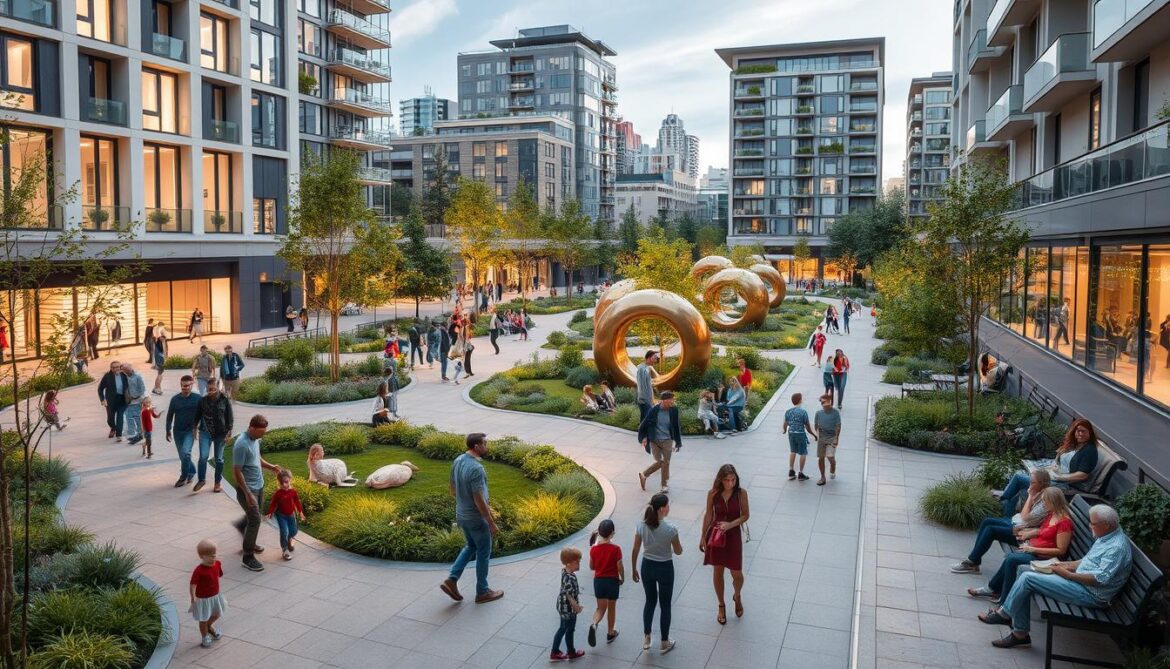 Furthermore, the integration of technology within urban infrastructure, as seen in smart cities like Dubai, can improve quality of life, enhance communication, and promote collaboration among all residents22.
Furthermore, the integration of technology within urban infrastructure, as seen in smart cities like Dubai, can improve quality of life, enhance communication, and promote collaboration among all residents22.
As urban designers navigate the evolving role of technology in shaping our cities, it is crucial to prioritise human-centred design and accessibility in cities. By leveraging data-driven insights, fostering digital inclusivity, and promoting social equity, urban design can harness the power of technology to create more inclusive and vibrant urban environments for all23.
“The study advocates for cities to be technologically advanced while fostering social interactions and community bonds, emphasizing the importance of integrating privacy measures and creating inclusive urban spaces.”
Evaluating the Outcomes of Urban Design Initiatives
Assessing the real-world impact of urban design projects is crucial for ensuring their effectiveness in promoting social equity. By establishing robust metrics for measuring success, cities can track both quantitative data, such as increased access to public transportation and reduced housing costs, as well as qualitative assessments, like improved quality of life and greater community satisfaction24.
Community feedback mechanisms, such as surveys and public forums, provide invaluable insights into the on-the-ground experiences of residents. These engagement tools allow urban planners to understand the lived realities of local communities and make design decisions that truly address their needs25.
Metrics for Measuring Success
Quantitative metrics for evaluating urban design initiatives may include data on public transit usage, affordable housing availability, walkability, and green space accessibility24. Qualitative assessments, on the other hand, can shed light on the social and emotional impact of these projects, capturing community perceptions of safety, inclusivity, and overall quality of life25.
Community Feedback Mechanisms
Engaging local residents through surveys, focus groups, and public forums is essential for understanding the nuanced effects of urban design on diverse communities. This feedback can inform design iterations, ensure accountability, and foster a sense of ownership among the people who will ultimately experience the built environment25.
Case Studies of Successful Urban Designs
Examining case studies of successful urban design initiatives, such as the Bus Rapid Transit system in Bogotá or the inclusionary zoning policy in San Francisco, can provide valuable insights for other cities seeking to implement equitable strategies. These examples demonstrate how thoughtful design, community collaboration, and policy interventions can create more liveable, accessible, and socially just urban environments24.
“Engaging with the community is seen as key to designing successful and enduring places with far-reaching effects.”25
By prioritising community feedback, measuring a range of success metrics, and learning from best practices, cities can ensure that their urban design initiatives have a meaningful and lasting social impact. This holistic approach to evaluating outcomes is essential for creating more equitable, inclusive, and sustainable communities2425.
Future Trends in Urban Design and Social Equity
The future of urban design is increasingly focused on promoting social equity and sustainable communities. Innovative approaches, such as green infrastructure, mixed-use developments, and smart city technologies, are shaping more inclusive and resilient urban environments26. Urban planners are putting greater emphasis on developing sustainable cities, with a focus on energy efficiency and ecological friendliness26. The growing importance of resilience in urban planning addresses critical challenges like climate change and economic disparities, ensuring cities can withstand and recover from disruptions efficiently.
Innovations Shaping Urban Environments
26 Green walls and roofs are being increasingly incorporated into urban areas to enhance air quality and reduce the urban heat island effect26. Smart grid technology is utilised for more effective and sustainable energy systems in urban planning, while26 technology integration into urban design is growing, enabling the development of smart cities for enhanced livability and efficiency26. Mixed-use developments are trending to create dynamic and varied communities, combining residential, commercial, and public areas, fostering social interaction and economic opportunities.
The Growing Importance of Resilience
Cities like Dallas are developing resilience strategies focused on transportation equity, healthcare access, and economic resilience to address the challenges posed by climate change and socioeconomic disparities26. Resilience in urban planning is crucial for cities to withstand shocks and recover efficiently from disasters or disruptions, ensuring the well-being of all residents26. Creatively repurposing old structures also contributes to preserving cultural heritage and stimulating economic growth, enhancing the resilience of urban communities.
Vision for Sustainable, Equitable Cities
The vision for sustainable, equitable cities involves creating urban spaces that are accessible, inclusive, and responsive to the needs of all residents, regardless of their socioeconomic background or demographic characteristics26. The emphasis on designing public spaces is increasing to create inclusive and vibrant cities, fostering a sense of community and belonging26. Affordable housing remains a significant challenge for urban designers to provide inclusive and accessible cities, addressing the discrepancies in urban regions and ensuring the development of equal and inclusive communities.
FAQ
What is the role of urban design in promoting social equity?
How can inclusive urban planning processes help achieve social equity?
What is the importance of public spaces in promoting social equity?
How can urban design address transportation equity?
What is the role of affordable housing in urban design and social equity?
How can technology contribute to socially equitable urban design?
What are the future trends in urban design that focus on social equity?
Source Links
- Bridging the Gap: Promoting Social Equity in the 1 18 Hour City – FasterCapital – https://fastercapital.com/content/Bridging-the-Gap–Promoting-Social-Equity-in-the-1-18-Hour-City.html
- The Importance of Urban Design for Your Community – https://mrsc.org/stay-informed/mrsc-insight/march-2020/the-importance-of-urban-design-for-your-community
- Social Equality in the Design of Public Spaces | Insights | Little – https://www.littleonline.com/insights/social-equality-in-the-design-of-public-spaces/
- Exploring the Relationship between Urban Design and Social Capital: A Systematic Quantitative Literature Review – https://www.mdpi.com/2673-8945/4/3/27
- How Urban Design and Architecture Influence Social Interaction and Community Building – https://www.linkedin.com/pulse/how-urban-design-architecture-influence-social-building-riya-bhorkar-tpngc
- Promoting Social Equity and Building Resilience through Value-Inclusive Design – https://www.mdpi.com/2075-5309/13/8/2081
- Social Equity – https://www.planning.org/knowledgebase/equity/
- Crafting Equitable Cities: The Imperative of Inclusive Urban Planning – https://royalblog.org/2024/10/13/crafting-equitable-cities-the-imperative-of-inclusive-urban-planning/
- The role of public spaces in social equity: designing for community and inclusivity – https://medium.com/@c_mennini/the-role-of-public-spaces-in-social-equity-designing-for-community-and-inclusivity-85354f458a4c
- Public Spaces and Social Equity | Social Equity | Parks and Recreation Magazine | NRPA – https://www.nrpa.org/parks-recreation-magazine/2017/march/public-spaces-and-social-equity/
- Designing with Empathy: Architecture for Social Equity – https://www.archdaily.com/1021532/designing-with-empathy-architecture-for-social-equity
- Three cities, three ways urban design can create social equity – https://perkinswill.com/insights/three-cities-three-ways-urban-design-can-create-social-equity/
- How Urban Design Can Promote Social Equity – https://www.planetizen.com/news/2022/04/116967-how-urban-design-can-promote-social-equity
- Urban Design’s Role in Creating Housing, Mitigating Climate Change, and Promoting Social Equity – https://commonedge.org/urban-designs-role-in-creating-housing-mitigating-climate-change-and-promoting-social-equity/
- How architectural design can improve social equity – https://www.cca.edu/newsroom/architectural-design-improves-social-equity/
- The Relationship between Social Cohesion and Urban Green Space: An Avenue for Health Promotion – https://pmc.ncbi.nlm.nih.gov/articles/PMC6388234/
- Growing Equity in City Green Space – Eos – https://eos.org/features/growing-equity-in-city-green-space
- Contested Urban Green Spaces and Environmental Justice in Northern Europe – https://link.springer.com/chapter/10.1007/978-3-031-04636-0_1
- Cultural diversity – (Public Art and Urban Design) – Vocab, Definition, Explanations | Fiveable – https://fiveable.me/key-terms/public-art-and-urban-design/cultural-diversity
- Cultural Competency – (Sustainable Urban Planning) – Vocab, Definition, Explanations | Fiveable – https://fiveable.me/key-terms/sustainable-urban-planning/cultural-competency
- Social justice implications of smart urban technologies: an intersectional approach | Buildings & Cities – https://journal-buildingscities.org/articles/10.5334/bc.290
- The Future of Urban Planning and Digital Transformation – https://www.dlrgroup.com/idea/future-urban-planning-digital-transformation/
- The Impact of Digital Technologies on Urban Life Quality and Social Dynamics in Bismayah – https://www.iieta.org/journals/ijsdp/paper/10.18280/ijsdp.190911
- The value of urban design – https://www.designcouncil.org.uk/fileadmin/uploads/dc/Documents/the-value-of-urban-design_0.pdf
- Learning from a Painful Past: How to Design for Racial and Social… – https://perkinswill.com/news/learning-from-a-painful-past-how-to-design-for-racial-and-social-equity/
- The Future Of Urban Design: Trends And Challenges – https://urbandesignlab.in/the-future-of-urban-design-trends-and-challenges/?srsltid=AfmBOoqUNZLi2cjOoSWJnxtI0YbTDgTTxy7u5tpi3BwId-FTD2FHQWBA






